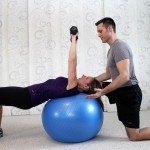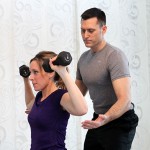Monitoring your heart rate during exercise is the best indicator of aerobic exercise intensity. When you exercise, the heart beats faster to meet the demand for more oxygenated blood entering muscle cells in order for your body to keep up with intense physical activities. The higher the intensity level of activity, the faster your heart will beat to pump oxygen and blood throughout your body. Therefore, monitoring your heart rate during exercise is an excellent way to check your intensity level.
Maximal heart rate is a number related to your age. The human heart starts to beat more slowly as we age. Thus, the heart pumps oxygenated blood throughout the body less efficiently. To estimate your maximal heart rate, subtract your age from 220. Theoretically, this is the fastest your heart can beat in one minute without your body having negative side effects (dizziness, unconsciousness, heart attack, stroke, etc.)
Your target heart rate zone is the number of beats per minute (bpm) at which your heart should be beating during aerobic exercise in order to promote optimal fitness levels, improving cardiovascular conditioning, and reducing body fat percentages. For most healthy individuals, this range is 60 to 80 percent of the maximal heart rate.
Measuring your heart rate while exercising can be done through two methods. Wearing a heart rate monitor is the easiest and most accurate method of checking your heart rate. A heart rate monitor can be purchased at any sporting goods supplier and ranges from $40 to $200. The least expensive are very accurate and will only display your heart rate, while the moderately and highly priced monitors offer a stop watch, warning sounds if your heart rate is too high or too low, standard clock, and many other features.
The second method for monitoring your heart rate is by checking your pulse on your radial artery. The radial pulse can be found on the under side of your wrist using your index and middle fingers held together. Once located, count the number of beats for 15 seconds and multiply that number by 4. This will give you your beats per minute. To be more accurate, count the number of beats in 60 seconds. Both methods are acceptable for determining your heart rate.
Now that you have determined your beats per minute (bpm), you must determine if you are exercising at an intensity within your target heart rate zone. Your target heart rate range is 60 to 85 percent of your maximal heart rate.





